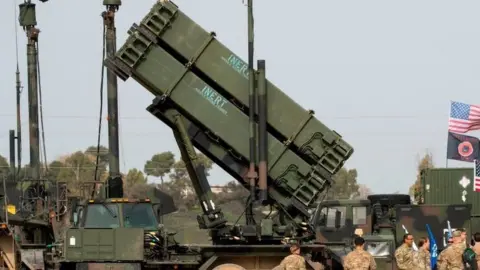Ukraine war: US Patriot missiles will comfort Kyiv and alarm Moscow
 Getty Images
Getty ImagesUkraine will get an advanced US-built Patriot defence missile system to try to counter Russian missile and drone attacks, the White House has confirmed ahead of Ukrainian President Volodymyr Zelensky's visit to Washington on Wednesday.
Since the start of the war in February, many Western air defences have been sent in - from man-portable Stinger shoulder-launched missiles, through to more advanced radar-guided and other heat-seeking systems. All provide a comprehensive level of protection against different threats.
Patriots are another step on that same path - and one which will antagonise Moscow.
They're not a silver bullet, but they are extremely capable, effective and expensive. One Patriot missile costs around $3m - three times the cost of a missile in a NASAMS (National Advanced Surface-to-Air Missile System). Two NASAM systems have been in operation in Ukraine for several weeks.
The new Patriot missile battery "will be a critical asset to defend the Ukrainian people against Russia's barbaric attacks on Ukraine's critical infrastructure", the White House said in a briefing.
Patriots were used against Iraq's Russian-made Scud missiles during the first Gulf War and have been continuously developed since by Raytheon Technologies. They come in batteries that include a command centre, a radar station to detect incoming threats - and launchers.
Ranges to target reportedly vary between 40km to 160km (100 miles), depending on the type of missile used. And they are what's termed "point defence" systems: generally designed to defend particular areas such as cities or important infrastructures - in other words high-value assets.

The US announcement refers to a single unit comprising a radar station, control system and, of course, the missile launchers.
It is likely to be placed around a high value asset or key city for additional protection. We will not know where, as once Western systems are in Ukrainian hands they effectively become Ukrainian property, under the command of the country's military.
No US or other Nato troops can operate these systems inside Ukraine, so like other Western weapons Ukrainian forces will have to be trained to use them - and that training will take place outside of their country. Such training could already be well under way and, more broadly, the US military has said it will expand its training for Ukrainian forces in Germany from January.
Moscow has called any plans to deploy Patriots "a provocation" and a further expansion of the United States' military involvement in Ukraine. Russia indicated that such missiles would become what it called "legitimate targets" for missile strikes, something that has been said before in this war.
The decision to send a battery is a clear statement that Washington remains committed to doing what is required for Ukraine to try to protect itself. Iran's involvement in supplying Russia with attack drones and perhaps other weapons increases the concern. The net effect is more advanced Western systems into Ukraine, something Moscow did not want to happen.
Precisely what overall effect Patriot systems will have is difficult to say.
They will certainly provide an additional layer of protection, but their size and expense means that few units will be able to be sent.
